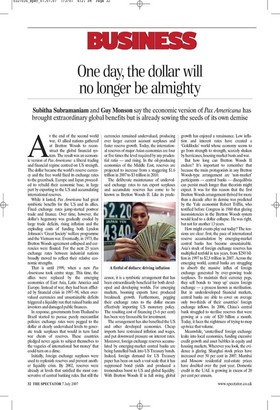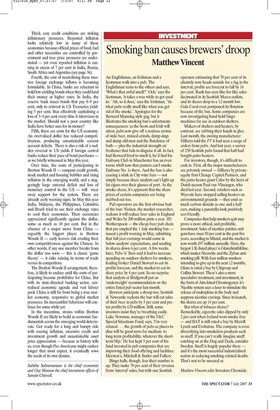One day, the dollar will no longer be almighty
Subitha Subramaniam and Guy Monson say the economic version of Pax Americana has brought extraordinary global benefits but is already sowing the seeds of its own demise At the end of the second world war, 43 allied nations gathered at Bretton Woods to reconstruct the global financial system. The result was an economic version of Pax Americana: a liberal trading and financial regime centred on US strength. The dollar became the world's reserve currency and the free world fixed its exchange rates to the greenback. Europe and Japan proceeded to rebuild their economic base, in large part by exporting to the US and accumulating international reserves.
While it lasted, Pax Americana had great symbiotic benefits for the US and its allies. Fixed exchange rates jump-started postwar trade and finance Over time, however, the dollar's hegemony was gradually eroded by large trade deficits, rising inflation and the exploding costs of funding both Lyndon Johnson's 'Great Society' welfare programme and the Vietnam war. Eventually, in 1973, the Bretton Woods agreement collapsed and currencies were floated. For the next 25 years exchange rates between industrial nations broadly moved to reflect their relative economic strengths.
That is until 1999, when a new Pax Americana took centre stage. This time, the allies were replaced by the emerging economies of East Asia, Latin America and Europe. Instead of war, they had been afflicted by financial crisis in 1997-98, when overvalued currencies and unsustainable deficits triggered a liquidity run that ruined banks and investors and damaged public finances.
In response, governments from Thailand to Brazil started to pursue purely mercantilist policies: exchange rates were pegged to the dollar at clearly undervalued levels to generate trade surpluses that would in turn fund war chests of reserves. These countries pledged never again to subject themselves to the vagaries of international 'hot money' that could turn on a dime.
Initially, foreign exchange surpluses were used to replenish reserves and prevent another liquidity crisis. By 2002, reserves were already at levels that satisfied the most conservative of central banking rules. But still the currencies remained undervalued, producing ever larger current account surpluses and faster reserve growth. Today, the international reserves of major Asian economies are four or five times the level required by any prudential ratio — and rising. In the oil-producing economies of the Middle East, reserves are projected to increase from a staggering $1.6 trillion in 2007 to $3 trillion in 2010.
The deliberate maintenance of undervalued exchange rates to run export surpluses and accumulate reserves has come to be known as Bretton Woods II. Like its predecessor, it is a symbiotic arrangement that has been extraordinarily beneficial for both developed and developing worlds. For emerging markets, booming exports have produced breakneck growth. Furthermore, pegging their exchange rates to the dollar means effectively importing US monetary policy. The resulting cost of financing (5-6 per cent) has been very favourable for investment.
The arrangement has also benefited the US and other developed economies. Cheap imports have restrained inflation and wages, and put downward pressure on interest rates. Moreover, foreign exchange reserves accumulated by emerging-market central banks are being funnelled back into US Treasury bonds. Indeed, foreign demand for US Treasury paper has been on such a vast scale that it has suppressed bond yields and produced a tremendous boost to US and global liquidity. With Bretton Woods II in full swing, global growth has enjoyed a renaissance. Low inflation and interest rates have created a `Goldilocks' world whose economy seems to go from strength to strength, scarcely shaken by hurricanes, housing market busts and war.
But how long can Bretton Woods II endure? It's important to remember that because the main protagonists in any Bretton Woods-type arrangement are 'non-market' participants — central banks — disequilibria can persist much longer than theorists might expect. It was for this reason that the first Bretton Woods arrangement thrived for more than a decade after its demise was predicted by the Yale economist Robert Triffin, who testified before Congress in 1960 that glaring inconsistencies in the Bretton Woods system would lead to a dollar collapse. He was right, but not for another 13 years.
How might events play out today? The tensions are clear: first, the pace of international reserve accumulation by emerging-market central banks has become unsustainable. Asia's stock of foreign exchange reserves has multiplied tenfold in ten years, from $250 billion in 1997 to $2.5 trillion in 2007. Across the emerging world, central banks are struggling to absorb the massive influx of foreign exchange generated by ever-growing trade surpluses. To maintain their currency pegs, they sell bonds to 'mop up' excess foreign exchange — a process known as sterilisation. But in underdeveloped financial markets, central banks are able to cover on average only two-thirds of their countries' foreign exchange inflows. In 2006, China's central bank struggled to sterilise reserves that were growing at a rate of $20 billion a month. Today, it faces the nightmare of trying to mop up twice that volume.
Meanwhile, 'unsterilised' foreign exchange leaks into local economies, funding excessive credit growth and asset bubbles in equity and housing markets. Wherever you look, the evidence is glaring. Shanghai stock prices have increased over 50 per cent in 2007. Mumbai and Moscow residential real-estate prices have doubled over the past year. Domestic credit in the UAE is growing in excess of 20 per cent per annum.
Third, easy credit conditions are stoking inflationary pressures. Reported inflation looks relatively low in many of these economies because official prices of food, fuel and other necessities are controlled by government and true price pressures are understated — yet even reported inflation is running in excess of 7 per cent in India, Russia, South Africa and Argentina (see page 36).
Fourth, the cost of neutralising these massive foreign exchange inflows is becoming formidable. In China, banks are reluctant to hold low-yielding bonds when they could lend their money at higher rates. In India, the reserve bank issues bonds that pay 8-9 per cent, only to reinvest in US Treasuries yielding 5 per cent, thus effectively capitalising a loss of 3-4 per cent every time it intervenes in the market. Should not a poor country like India have better uses for its money?
Fifth, there are costs for the US economy. An overvalued dollar has reduced competitiveness, producing unsustainable current account deficits. There is also a risk of a sudden reversal in US yields if foreign central banks reduce their pace of bond purchases — as we briefly witnessed in May this year.
Over time, the costs of participating in Bretton Woods II — rampant credit growth, stock market and housing bubbles and rising inflation in the emerging world, and a staggeringly large external deficit and loss of monetary control in the US — will wear away support for the system. There are already early warning signs. In May this year India, Malaysia, the Philippines, Colombia and Brazil tried to use their exchange rates to cool their economies. Their currencies appreciated significantly against the dollar, some as much as 10 per cent. But in the absence of a major move from China — arguably the biggest player in Bretton Woods II — early leavers risk eroding their own competitiveness against the Chinese. In other words, if any one member breaks from the dollar too soon — this is classic 'game theory' — it risks ruining its terms of trade versus its competitors.
The Bretton Woods II arrangement, therefore, is likely to endure until the costs of participating become prohibitive for China. But with its state-directed banking sector, centralised economic agenda and vast labour pool, China is still far from being a true market economy, responsive to global market pressures. Its mercantilist behaviour will continue for some while yet.
In the meantime, strains within Bretton Woods II are likely to build as economic fundamentals across the emerging world deteriorate. Get ready for a long and bumpy ride with soaring inflation, excessive credit and investment growth and unsustainable asset price appreciation — because as history tells us, even though Roc Americana might endure longer that most expect, it eventually sows the seeds of its own demise.
Subitha Subramaniam is the chief economist and Guy Monson the chief investment officer of Sarasin www.spectator.co.uk




















































 Previous page
Previous page